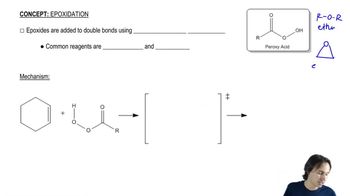What is the major product of the reaction of 2-methyl-2-butene with each of the following reagents?
f. MCPBA (a peroxyacid)
 Verified step by step guidance
Verified step by step guidance Verified video answer for a similar problem:
Verified video answer for a similar problem:



 2:19m
2:19mMaster General properties of epoxidation. with a bite sized video explanation from Johnny
Start learning